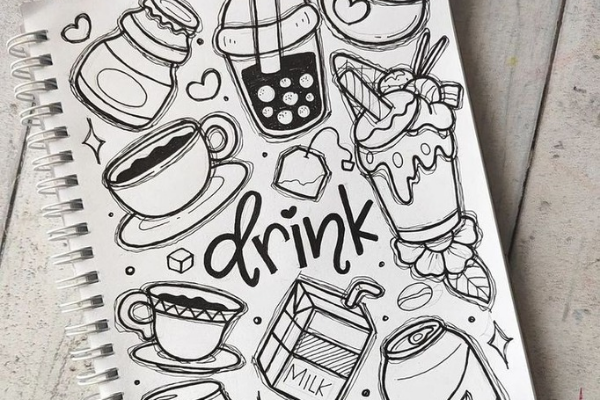Hello and welcome to my blog! Today, we’re going to dive into the delightful world of doodle art. Whether you’re an experienced artist or someone who enjoys scribbling in the margins of your notebook, doodle art offers a fun and relaxing way to express your creativity. Let’s explore what doodle art is, its benefits, the best materials for creating doodles, and some tips to help you get started.

What is Doodle Art?
Doodle art is a form of drawing that involves spontaneous, free-form sketches. These drawings can range from simple shapes and patterns to more complex and detailed illustrations. Doodling often happens without much conscious thought, making it a natural and easy way to unleash your creativity.
Doodles can be abstract, featuring lines, swirls, and shapes, or they can depict recognizable objects, animals, and characters. The beauty of doodle art is that there are no rules—it’s all about letting your imagination flow and enjoying the process.
The Benefits of Doodling
- Boosts Creativity: Doodling stimulates the brain and encourages creative thinking. It helps you think outside the box and come up with new ideas.
- Reduces Stress: The repetitive and rhythmic nature of doodling can be very soothing, helping to reduce stress and anxiety.
- Improves Focus: Contrary to what you might think, doodling can actually help you concentrate. It keeps your brain engaged, making it easier to focus on tasks.
- Enhances Memory: Studies have shown that doodling while listening to information can improve your ability to remember that information later.
- Enhances Fine Motor Skills: Regular doodling can improve hand-eye coordination and fine motor skills, which are useful for various activities.
Best Materials for Doodle Art
Starting with doodle art doesn’t require a lot of fancy equipment. However, having the right materials can make your doodling experience more enjoyable and allow you to create more detailed and vibrant artwork. Here are some of the best materials for doodle art:
- Paper
- Drawing Paper: Smooth and ideal for detailed work.
- Watercolor Paper: Thicker and textured, great for adding paint.
- Black Paper: Creates a striking contrast with white and metallic pens.
- Pencils
- Graphite Pencils: For sketching and outlining. A range from hard (H) to soft (B) provides different shading effects.
- Mechanical Pencils: For fine lines and details.
- Erasers
- Kneaded Erasers: Gentle on paper and adjustable for precise erasing.
- Vinyl Erasers: Clean and precise for removing pencil marks.
- Rulers and Geometry Tools
- Rulers: For straight lines and precise measurements.Compasses: For drawing perfect circles.Protractors: For accurate angles.Templates: For consistent shapes and patterns.

- Pens and Markers
- Fineliners: For detailed and precise line work.
- Gel Pens: For vibrant colors and special effects.
- Brush Pens: For varying line thickness and calligraphy-style effects.
- Colored Pencils
- Wax-Based Colored Pencils: Smooth application and vibrant colors.
- Oil-Based Colored Pencils: Blend well and offer rich, intense colors.
- Paints
- Watercolors: For translucent and layered effects.
- Acrylics: For bold, opaque colors.
- Gouache: For a matte finish and vibrant colors.
- Brushes
- Round Brushes: For detailed work and fine lines.Flat Brushes: For broad strokes and filling large areas.Detail Brushes: For intricate patterns and tiny details.
Tips for Creating Doodle Art
- Start Simple: Begin with basic shapes and patterns, and gradually move to more complex designs.
- Practice Symmetry: Use guidelines and tools to maintain symmetry in your designs.
- Experiment with Colors: Don’t be afraid to try different color combinations and techniques.
- Take Your Time: Creating doodle art is a meditative process. Enjoy each step and don’t rush.
- Keep Learning: Explore tutorials, books, and online resources to continually improve your skills.
- Stay Organized: Keep your materials organized and easily accessible. It makes the process smoother and more enjoyable.
- Share Your Work: Share your doodles with friends or online communities. Feedback and encouragement can be very motivating.

Popular Doodle Art Styles
- Mandala Doodles: Similar to mandala art, these doodles are circular designs with symmetrical patterns. They often have a spiritual or calming effect.(want to know more about mandala art? check it out)
- Zentangle: A structured form of doodling that involves creating intricate patterns within defined spaces. Zentangle art is meditative and focuses on creating detailed, repetitive designs.
- Cartoon Doodles: Simple drawings of characters, objects, or scenes that often have a whimsical or humorous touch.
- Abstract Doodles: Free-form designs that don’t follow any specific pattern or theme. These doodles are all about letting your imagination run wild.
- Lettering Doodles: Incorporating decorative letters and typography into your doodles. This style combines art with creative writing.
Summary
Doodle art is a wonderful way to express yourself, relax, and boost your creativity. It’s accessible to everyone and doesn’t require any special skills or materials. Whether you doodle for fun, relaxation, or personal expression, it’s a rewarding activity that can bring joy and satisfaction.
Thank you for joining me on this doodling adventure. I hope this guide inspires you to pick up a pen and start doodling today. Happy creating!
Table of Contents
Follow Artup for more art related ideas/blogs💡
-by keshava Upadhya